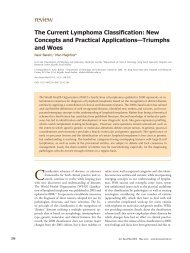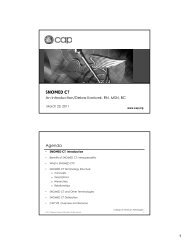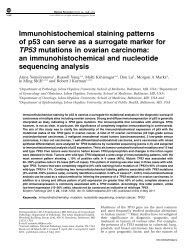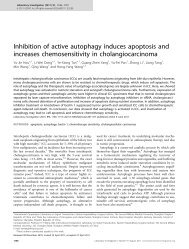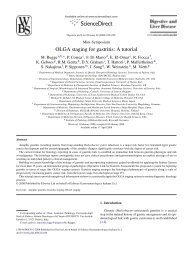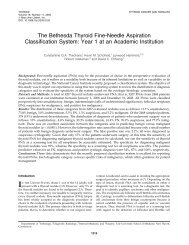SUBTYPES OF OVARIAN CARCINOMA 427same way as endometrioid <strong>carcinoma</strong>s 20 (see later). Mostprimary <strong>ovarian</strong> mucinous <strong>carcinoma</strong>s are well or moderatelydifferentiated (grade 1 or 2) and confined to the ovary.Occasionally, especially in the context <strong>of</strong> a borderline mucinousneoplasm, there is a sharp demarcation between a borderlinearea and a solid cellular area, a so-called mural nodule. 70,71The mural nodules may be benign (either sarcoma-like composed<strong>of</strong> a mixture <strong>of</strong> osteoclast-like giant cells, inflammatorycells and mononuclear cells or corresponding to some specificbenign neoplasm such as leiomyoma, rhabdomyoma or haemangioma)or malignant. The malignancy is most commonlyanaplastic <strong>carcinoma</strong> but may be sarcoma or carcinosarcoma. 70The anaplastic <strong>carcinoma</strong> may be composed <strong>of</strong> spindled,pleomorphic or rhabdoid cells. 70 It is likely that some previouslyreported examples <strong>of</strong> sarcoma-like mural nodulesactually represent anaplastic spindle cell <strong>carcinoma</strong> and cytokeratinsstains may be useful in confirming this.Immunohistochemistry <strong>of</strong> primary <strong>ovarian</strong> mucinous<strong>carcinoma</strong>sAs discussed, most primary <strong>ovarian</strong> mucinous <strong>carcinoma</strong>s (andborderline tumours) are <strong>of</strong> so-called intestinal type. Intestinaltype <strong>ovarian</strong> mucinous neoplasms are typically diffuselypositive with CK7 but also commonly express, focally ordiffusely, enteric markers such as CK20, CDX2, CEA andCA19.9 and are negative with hormone receptors, CA125 andWT1. 72,73 CA19.9 especially is <strong>of</strong>ten diffusely positive andthere may be elevation <strong>of</strong> the serum level <strong>of</strong> this marker. 74Serum CA19.9 levels may be extremely high and are <strong>of</strong> novalue in predicting preoperatively whether an <strong>ovarian</strong> mucinousneoplasm is benign, borderline or malignant. 74Molecular events in primary <strong>ovarian</strong> mucinous <strong>carcinoma</strong>sSimilar to low grade serous <strong>carcinoma</strong>s, <strong>ovarian</strong> mucinoustumours <strong>of</strong> intestinal type commonly exhibit k-ras mutationsand identical mutations have been demonstrated in benign,borderline and malignant areas within the same neoplasm,suggesting that k-ras mutation is an early event in the evolution<strong>of</strong> these tumours. 75–77 Unlike low grade serous <strong>carcinoma</strong>s,b-raf mutations are not a feature <strong>of</strong> <strong>ovarian</strong> mucinousneoplasms <strong>of</strong> intestinal type.Behaviour <strong>of</strong> primary <strong>ovarian</strong> mucinous <strong>carcinoma</strong>sAs discussed previously, most primary <strong>ovarian</strong> mucinous <strong>carcinoma</strong>s<strong>of</strong> intestinal type are unilateral and stage I. Advancedstage (stage III or IV) primary <strong>ovarian</strong> mucinous <strong>carcinoma</strong>sare very rare and a secondary should always be excluded. Theprognosis <strong>of</strong> stage I primary <strong>ovarian</strong> mucinous <strong>carcinoma</strong> isrelatively good, although some cases recur, usually in the pelvisor abdomen; recurrence is associated with a poor prognosis. Inone recent population-based study <strong>of</strong> 31 primary <strong>ovarian</strong>mucinous <strong>carcinoma</strong>s, eight <strong>of</strong> 31 recurred. 65 Infiltrative stromalinvasion is associated with a worse prognosis than expansileinvasion. Advanced stage primary <strong>ovarian</strong> mucinous <strong>carcinoma</strong>shave a dismal prognosis and respond poorly to thetraditional chemotherapeutic agents used to treat <strong>ovarian</strong> <strong>carcinoma</strong>s.However, it is again stressed that these are extremelyuncommon. Malignant mural nodules are usually associatedwith a poor prognosis, although a recent study has shown thatstage 1A tumours with malignant mural nodules may beassociated with a relatively favourable outcome. 70ENDOMETRIOID ADENOCARCINOMAMost, but not all, <strong>ovarian</strong> endometrioid adeno<strong>carcinoma</strong>s arelow grade and low stage (usually confined to the ovary, stage I).They are usually unilateral but approximately 10% are bilateral.They <strong>of</strong>ten, although not always, arise from endometriosis(especially an endometriotic cyst) or a pre-existing borderlineaden<strong>of</strong>ibroma. 78,79 The prevalence <strong>of</strong> primary <strong>ovarian</strong> endometrioidadeno<strong>carcinoma</strong> is lower in recent than in olderstudies. 7,8 This is almost certainly due to the recognition thatmany neoplasms which were previously diagnosed as highgrade and high stage endometrioid <strong>carcinoma</strong>s are, in fact,serous in type. This is an area where previously there was poorreproducibility amongst pathologists and where WT1 stainingmay be useful (discussed later). With an endometrioid adeno<strong>carcinoma</strong>involving the ovary, there is not uncommonly asynchronous endometrioid proliferation, either premalignant ormalignant, within the uterine corpus. 80 If conservative management(unilateral salpingo-oophorectomy) is undertaken for astage I <strong>ovarian</strong> endometrioid adeno<strong>carcinoma</strong>, the endometriumshould be sampled to exclude significant pathology here.Diagnosing a low grade endometrioid adeno<strong>carcinoma</strong> isusually straightforward, although problems may arise in thedistinction between a grade 1 endometrioid adeno<strong>carcinoma</strong>and a borderline endometrioid aden<strong>of</strong>ibroma. 79 Some lowgrade endometrioid adeno<strong>carcinoma</strong>s exhibit obvious stromalinvasion but in many (probably the majority) the diagnosis ismade on the basis <strong>of</strong> a back-to-back glandular architecture withexclusion <strong>of</strong> stroma, similar to the criteria used to diagnose anendometrioid adeno<strong>carcinoma</strong> <strong>of</strong> the endometrium (Fig. 7).The presence <strong>of</strong> glandular confluence and a back-to-backarchitecture with stromal exclusion should result in a diagnosis<strong>of</strong> endometrioid adeno<strong>carcinoma</strong> even when the cytologicalfeatures are low grade. The presence <strong>of</strong> one or more <strong>of</strong> theimportant triad <strong>of</strong> aden<strong>of</strong>ibromatous areas, squamous elements(morular or non-morular) and endometriosis may be a usefulpointer towards an endometrioid neoplasm. Unusual morphologicalfeatures occasionally seen in <strong>ovarian</strong> endometrioidadeno<strong>carcinoma</strong>s, either focally or diffusely, include sexcord-like formations and spindle cell differentiation; thesefeatures also occur more uncommonly in the correspondinguterine neoplasms. 81 The other morphological variants <strong>of</strong>uterine endometrioid adeno<strong>carcinoma</strong>, such as secretory andoxyphilic, may also occur in the ovary. High grade <strong>ovarian</strong>Fig. 7 Low grade endometrioid adeno<strong>carcinoma</strong> <strong>of</strong> ovary with back to backglandular arrangement.Copyright © Royal College <strong>of</strong> pathologists <strong>of</strong> Australasia. Unauthorized reproduction <strong>of</strong> this article is prohibited.
428 MCCLUGGAGE <strong>Pathology</strong> (2011), 43(5), AugustTable 4 Markers <strong>of</strong> use in distinction between <strong>ovarian</strong> endometrioid adeno<strong>carcinoma</strong>and colorectal adeno<strong>carcinoma</strong>Ovarian endometrioid adeno<strong>carcinoma</strong>Colorectal adeno<strong>carcinoma</strong>CK7 Diffusely positive NegativeCK20 Negative Diffusely positiveER Diffusely positive NegativeCA125 Diffusely positive NegativeCEA Negative Diffusely positiveCDX2 Negative or focally positive(squamous morules are positive)Diffusely positiveendometrioid adeno<strong>carcinoma</strong>s exist but are relatively uncommon.The distinction between a high grade endometrioid and ahigh grade serous <strong>carcinoma</strong> is discussed later. Endometrioidadeno<strong>carcinoma</strong>s <strong>of</strong> the ovary are usually ER positive, negativewith WT1, negative or patchily positive with p16 and exhibit‘wild-type’ staining with p53. Occasionally there is an admixture<strong>of</strong> low grade (grade 1 or 2) endometrioid adeno<strong>carcinoma</strong>and undifferentiated <strong>carcinoma</strong>, so-called dedifferentiatedendometrioid <strong>carcinoma</strong> (this is discussed later in the sectionon undifferentiated <strong>carcinoma</strong>).Metastatic adeno<strong>carcinoma</strong>s from several sites, especiallythe colorectum, may mimic a primary <strong>ovarian</strong> endometrioidadeno<strong>carcinoma</strong>. 49–52 Careful morphological examination(squamous elements, aden<strong>of</strong>ibromatous areas or endometriosissuggesting an endometrioid adeno<strong>carcinoma</strong>; segmental ordirty necrosis or a garland-like growth pattern suggesting acolorectal adeno<strong>carcinoma</strong>) combined, if necessary, withimmunohistochemistry facilitates the distinction. Differentialcytokeratin (CK7 and CK20) staining is virtually diagnostic inthe distinction between an endometrioid adeno<strong>carcinoma</strong> and ametastatic colorectal adeno<strong>carcinoma</strong> with a pseudoendometrioidappearance. Other markers which may assist include ER,CA125, CEA and CDX2 (Table 4). 53–60 The latter is an entericmarker which is diffusely positive in most colorectal adeno<strong>carcinoma</strong>sbut which on occasions is focally positive in<strong>ovarian</strong> endometrioid <strong>carcinoma</strong>s (personal observations);squamous morules, which are common in endometrioid proliferationswithin the ovary and endometrium, are almostalways CDX2 positive. 82In the Royal College <strong>of</strong> Pathologists Ovarian Cancer Dataset,20 it is recommended that <strong>ovarian</strong> endometrioid adeno<strong>carcinoma</strong>sare graded using the FIGO system used to gradeuterine endometrioid adeno<strong>carcinoma</strong>s. Although less extensivelystudied, endometrioid adeno<strong>carcinoma</strong>s <strong>of</strong> the ovaryexhibit similar molecular events to those seen in uterineendometrioid adeno<strong>carcinoma</strong>s; these include PTEN, b-catenin,k-ras and PIK 3CA mutations and microsatellite instability.83 b-catenin mutations are especially characteristic <strong>of</strong> lowgrade endometrioid adeno<strong>carcinoma</strong>s with squamous morules.84CLEAR CELL CARCINOMARecent studies suggest that primary <strong>ovarian</strong> clear cell <strong>carcinoma</strong>soccur with approximate equal frequency to endometrioidadeno<strong>carcinoma</strong>s. Clear cell <strong>carcinoma</strong>s are typicallycomposed <strong>of</strong> cells with abundant clear cytoplasm, <strong>of</strong>ten withprominent cell membranes; an oxyphilic variant also exists. 85The latter is usually a focal finding within an otherwise typicalclear cell <strong>carcinoma</strong> but occasionally is the predominant orexclusive element. Clear cell <strong>carcinoma</strong>s have a characteristicmorphological appearance typically consisting <strong>of</strong> an admixture<strong>of</strong> architectural arrangements including tubulocystic, glandular,solid and papillary (Fig. 8). Hobnail cells and eosinophilicstromal hyalinisation are common. 85 A plasmacytic or neutrophilicinfiltrate may be present. Some have a low powerarchitecture which closely mimics a serous borderlinetumour. 86 On occasions, a component <strong>of</strong> benign or borderlineclear cell aden<strong>of</strong>ibroma is identified, although it may bedifficult to ascertain whether this represents a precursor lesionor merely a growth pattern in a clear cell <strong>carcinoma</strong>. It is theadmixture <strong>of</strong> architectural patterns which is more characteristic<strong>of</strong> clear cell <strong>carcinoma</strong> than the presence <strong>of</strong> clear cells per sesince clear cells are sometimes a feature <strong>of</strong> both serous andendometrioid <strong>carcinoma</strong>s. In the absence <strong>of</strong> the architecturalfeatures listed, a diagnosis <strong>of</strong> clear cell <strong>carcinoma</strong> should bedoubted. 85 Most clear cell <strong>carcinoma</strong>s are diagnosed at earlystage (stage I or II) and the majority arise in endometriosis.Careful pathological sampling, especially concentrating oncystic areas, will usually reveal background endometriosis,<strong>of</strong>ten in the form <strong>of</strong> an endometriotic cyst.Most authorities recommend that <strong>ovarian</strong> clear cell <strong>carcinoma</strong>sare automatically graded as grade 3. 20 Since theseneoplasms are <strong>of</strong>ten architecturally well differentiated, sometimeshave a relatively low cytological grade and are typicallymitotically quite inactive (average 3–4 mitoses per 10 highpower fields 85 ), formal grading using one <strong>of</strong> the universalsystems may result in these being categorised as grade 1 or2. Clear cell <strong>carcinoma</strong>s are usually negative with ER, WT1 andp53 (so-called ‘triple negative’). They are usually negative orfocally positive with p16.It is widely assumed that clear cell <strong>carcinoma</strong>s have arelatively poor prognosis. However, the prognosis <strong>of</strong> stage I<strong>ovarian</strong> clear cell <strong>carcinoma</strong>s is relatively good. Advancedstage clear cell <strong>carcinoma</strong>s have a poor prognosis and appearrelatively resistant to the traditional chemotherapeutic agentsused in the treatment <strong>of</strong> <strong>ovarian</strong> <strong>carcinoma</strong>; it is possible thatthis is because these neoplasms exhibit a low proliferationindex.The underlying molecular events in <strong>ovarian</strong> clear cell <strong>carcinoma</strong>have not been extensively investigated 87 but a recentstudy identified ARID1A mutations in a significant percentage<strong>of</strong> cases. 88TRANSITIONAL CARCINOMAIn my opinion, primary <strong>ovarian</strong> transitional <strong>carcinoma</strong>s arerare, although they do exist. 89 I feel most tumours which arediagnosed as transitional <strong>carcinoma</strong> represent variants <strong>of</strong> highgrade serous <strong>carcinoma</strong> and that transitional <strong>carcinoma</strong> is apoorly reproducible diagnosis. Other tumours diagnosed astransitional <strong>carcinoma</strong> may represent endometrioid adeno<strong>carcinoma</strong>swith a transitional-like growth pattern. Transitional<strong>carcinoma</strong>s <strong>of</strong> the ovary express müllerian and not urothelialmarkers and are usually positive with WT1, 90 a point in favour<strong>of</strong> many being variants <strong>of</strong> high grade serous <strong>carcinoma</strong>. Somerecur or metastasise as high grade serous <strong>carcinoma</strong> and this isfurther evidence that many are variants <strong>of</strong> the latter.UNDIFFERENTIATED CARCINOMAThe WHO definition <strong>of</strong> an undifferentiated <strong>ovarian</strong> <strong>carcinoma</strong>is a primary <strong>ovarian</strong> <strong>carcinoma</strong> with no differentiation or onlysmall foci <strong>of</strong> differentiation. 6 These are uncommon but not rareCopyright © Royal College <strong>of</strong> pathologists <strong>of</strong> Australasia. Unauthorized reproduction <strong>of</strong> this article is prohibited.




